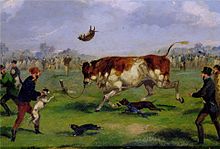Bear and bullbaiting
Bear and bullbaiting was a form of animal fighting in which attack dogs are set upon bears , bulls and other animals. In the 16th and 17th centuries it was carried out as a form of theatrical entertainment in England , for which special buildings were created, which were called beargarden .
procedure
In 1584 the German traveler Lupold von Wedel described in detail the dramaturgy and variants of such an event:
- Bear chasing: one after the other three bears of different sizes are chased by dogs
- Horse rush: a horse is sent into the arena to loosen up
- Bull chasing: a bull is chased
- Men and women come into the arena dancing, improvising and fighting. A man throws bread into the crowd. Above the audience is a rose that is set on fire and then loses apples and pears. The spectators fight for the treasures and are additionally excited by the mixed fireworks.
- Big final fireworks
Bear baiting
Brown bears or black bears with their claws and fangs removed were tied to a pole in the middle of an arena with a nose ring or necklace. Then the dogs were admitted, who attacked the bear and tried to grab him by the throat or by the muzzle. If this goal was achieved, the combatants were separated and the combat round was over. The fight itself wasn't over until the bear was visibly exhausted. The death of the animal was not intended.
Bull-baiting
During this hunt a bull whose horns were blunted was tied to a stake. The bulldogs of that time also had to reach the neck or the muzzle. The bull's death may have been factored in or was brought about after the fight, because bull meat was only considered edible if the animal was hounded.
Ape on horseback
Instead of a wild animal, a horse was led into the arena with a monkey tied to its back. The horse was allowed to move freely. Since horses were not that valuable, their death was probably planned. The origin of this form seems to lie in the training of dogs to fight against cavalrymen. This number was considered strange (due to the screaming monkey) and served to loosen up.
Whipping of the Blind Bear
A blind bear was tied to a stake and young men in particular tried to show their courage by hitting the animal with rods or whips.
Old English bulldogs
In England in particular, powerful dogs were bred specifically for bullbaiting (German: bull biting ), whose task it was to wrestle bulls in exhibition fights. This form of animal fighting enjoyed great popularity in England from the 16th to the 18th centuries and was a popular sport for people of all classes, in which large sums were bet.
The entire exterior of the bulldogs (English bulldogs ) was designed to grab bulls by the nose and pull them to the ground. The ideal bulldog was stocky, medium-sized, stable, had a stocky body with a broad chest and enormous strength in the neck and jaw area. Further characteristic features were a large head with a heavily folded fore-face and rose ears . The short nose and the protruding lower jaw ( undershot ) allowed firm and long gripping without suffocating.
After bull biting was banned in England in 1835, the history of the bulldog took a different turn.


